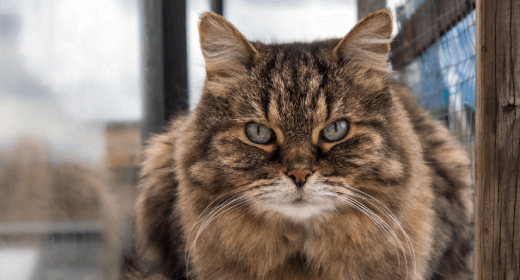

Cats are creatures of habit and can resist diet change. It's important to completely stop feeding your cat from the table. This is best accomplished by removing the cat from the kitchen during mealtimes. Be persistent when offering dry food. Your cat may refuse to eat for several meals before deciding to give the food a try. Heating food in the microwave increases the aroma of the food and will often entice a cat to eat. Another alternative is to try mixing some wet food with the dry food, or topping it with a sauce or gravy specifically formulated for pets. Be assured that your cat eats to meet an energy need and will eventually begin to eat unless there is an underlying medical issue.
Keep in mind that your cat's stool should be small and firm. Most cases of constipation are temporary and due to dietary interruptions. Loose stools also are often temporary and can be due to dietary interruptions, as well as many other things, including an abrupt change in diet, overeating, parasites, medication, eating table scraps, viral or bacterial infections, and stress. If constipation or diarrhea persists, however, it is important to consult a veterinarian.


Is your feline leaving puddles of urine in your bathtub or on your tile floors? Making lots (and lots) of trips to the litter box? Or crying out in pain when they pee?
Sounds like
tinkling trouble.
Your furry friend might have feline lower urinary tract disease (FLUTD), which is just scientific jargon for a collection of painful conditions that can wreak havoc on your kitty’s bladder and/or urethra.
Some of the most common FLUTD diseases include urinary tract infections, urinary stones caused by a buildup of minerals, obstructions within the urethra or an inflamed bladder.
Not drinking enough water
Not urinating often enough
A urine pH level that’s too high
Too many minerals and not enough water in the urine
Being a male cat — because their urethras are longer and narrower
Stress or anxiety
Keep your
eyes peeled for
peeing problems ...
The Opens a new window American Veterinary Medical Association says to watch for these major signs:
Straining to go
Frequently urinating a little at a time
Prolonged attempts to go
Crying out while urinating
Excessively licking their genital area
Peeing outside the litter box
Passing blood in their urine
Get your cat back
on the right tract.
First things first, if your feline seems to be in a lot of pain or isn’t able to pee at all, get to the vet — stat!
Your cat might have a urethral obstruction, a life-threatening condition that your veterinarian must treat quickly!
Seriously, don’t dillydally.
Feed smaller, more frequent meals.
Always provide your cat with clean, fresh water.
Encourage your feline to drink as much as possible to help keep mineral buildup at bay and flush your feline’s urinary system.
Be sure you have the right number of litter boxes — usually one more box than the number of cats you have.
Place litter boxes in quiet parts of the house.
Always keep litter boxes clean — they should be scooped once or twice a day.
Maintain a steady routine and make your home as stress-free as possible. Consider how your own stress level, any visiting house guests and any other pets might be affecting your cat.
Take this old adage to heart:
“An ounce of prevention is worth a pound of cure.”
In addition to the tips above, feed your cat delicious Opens a new window IAMS™ PROACTIVE HEALTH™ Urinary Tract Health, made with real chicken.
It helps promote your cat’s urinary system health by reducing urinary pH and helping to control mineral levels.
How’s that for
a win-win?!
We use a sodium salt to acidify urine and help prevent struvite crystals from forming.
Our formula helps control levels of calcium, magnesium and phosphorus in your cat’s urine, which is a good thing!
Next stop? Litter box bliss.
(Ahhhh.)

